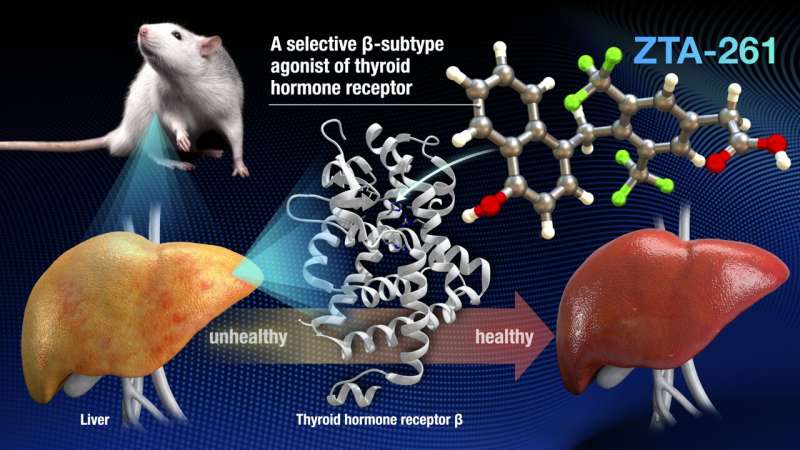This article has been reviewed according to Science X's editorial process and policies. Editors have highlighted the following attributes while ensuring the content's credibility:
fact-checked
peer-reviewed publication
trusted source
proofread
Controlling lipid levels with less side effects possible with new drug

Scientists at Nagoya University in Japan have made a significant breakthrough in treating lipid disorders. They have developed a new compound, ZTA-261, which selectively binds to the thyroid hormone receptor beta (THRβ).
THRβ plays an important role in the regulation of lipid metabolism, which affects lipid levels in the blood. Mice administered the drug showed decreased lipid levels in the liver and blood, with fewer side effects in the liver, heart, and bones compared to existing compounds.
These findings, published in Communications Medicine, suggest that ZTA-261 is an effective treatment for lipid disorders such as dyslipidemia.
Approximately one in 10 people is classified as obese or overweight, often due to abnormalities in lipid metabolism. Abnormal levels of lipids in the blood, known as dyslipidemia, lead to an increased risk of chest pain, heart attack, and stroke.
There is growing interest in developing treatments for dyslipidemia that leverage the properties of thyroid hormones. Thyroid hormones increase overall metabolism through binding to two types of receptors: alpha (THRα) and beta (THRβ). The brain, heart, and muscle contain the α-subtype, whereas the liver and pituitary gland primarily express the β-subtype.
Treatments that rely on THR activation face challenges due to the side effects of thyroid hormones. Although THRα regulates cardiovascular functions, excess levels of thyroid hormone lead to adverse effects in nearby organs such as heart enlargement and muscle and bone wasting. On the other hand, activation of THRβ influences lipid metabolism without these severe side effects.
As a result, THRβ has become a desirable target for treating metabolic disorders such as dyslipidemia. However, common treatments, such as the natural thyroid hormone T3, show almost no selectivity between the α and β receptors, making it difficult to avoid the severe side effects caused by binding to THRα.
To address this problem, a research team, including Masakazu Nambo, Taeko Ohkawa, Ayato Sato, Cathleen Crudden, and Takashi Yoshimura from Nagoya University's WPI-ITbM, developed ZTA-261, a thyroid hormone derivative drug with a similar structure. To test its efficacy, they compared it with GC-1, another thyroid hormone derivative, and the natural thyroid hormone T3 in a mouse model.
They found that ZTA-261 had almost 100 times higher selectivity for THRβ than THRα. In comparison, GC-1 showed only a 20-fold difference in affinity, showing ZTA-261's superior selectivity. This was confirmed by the significant increase in heart weight and bone damage indicators in T3-treated mice but not in those treated with ZTA-261.
"Our findings suggest that ZTA-261 is much less toxic than T3 and even less toxic than GC-1, which is known as a THRβ-selective compound," Ohkawa said. "I find it amazing that the difference in THR beta-selectivity between ZTA-261 and GC-1—100 times selectivity vs. 20 times selectivity—truly has this big an impact on heart and bone toxicity."
As many drugs have been discontinued in preclinical trials because of their toxicity in the liver, the researchers checked for potential liver toxicity by measuring alanine aminotransferase (ALT) levels in the blood.
Their findings confirmed the safety of the drug, finding no significant differences in ALT levels between mice treated with ZTA-261 and those treated with saline. Although these results are promising,more studies, including human trials, will be necessary before considering ZTA-261 for clinical use. However,this breakthrough represents a significant step forward in the development of safer treatments for lipid disorders.
"ZTA-261 has extremely high affinity and selectivity for THRβ among the thyroid hormone derivatives developed to date," Nambo explained. "In the process of synthesizing a variety of derivatives, we have found that precise molecular design is crucial for both selectivity and affinity. We believe that this study will provide new and important insights into drug discovery."
More information: Nambo, M., et al, Synthesis and preclinical testing of a selective beta-subtype agonist of thyroid hormone receptor ZTA-261, Communications Medicine (2024). DOI: 10.1038/s43856-024-00574-z




















